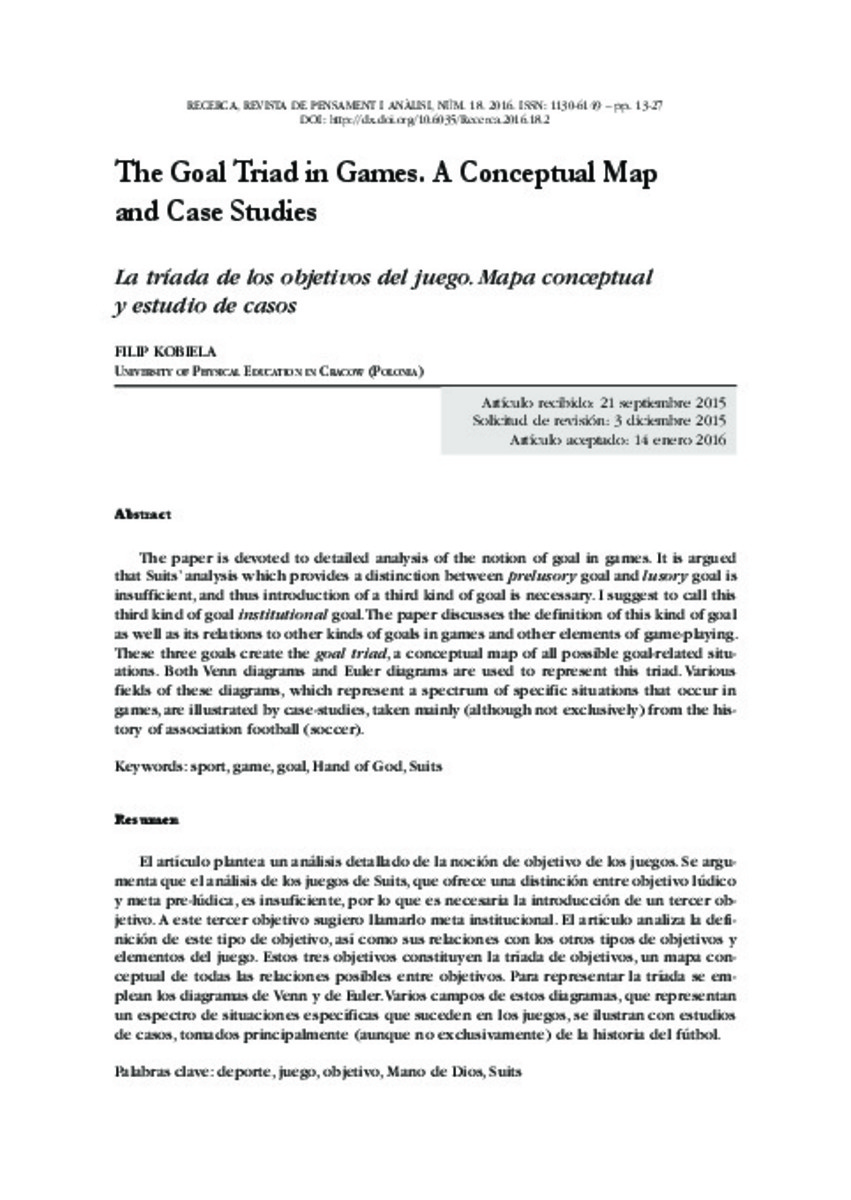Mostrar el registro sencillo del ítem
The Goal Triad in Games: A Conceptual Map and Case Studies
| dc.contributor.author | Kobiela, Filip | |
| dc.date.accessioned | 2017-02-10T11:12:33Z | |
| dc.date.available | 2017-02-10T11:12:33Z | |
| dc.date.issued | 2016 | |
| dc.identifier.issn | 1130-6149 | |
| dc.identifier.issn | 2254-4135 | |
| dc.identifier.uri | http://hdl.handle.net/10234/165982 | |
| dc.description.abstract | Although the very existence and need for an exact definition of sport is still debatable, there is common agreement that competitive sport events on elite level are, among others, goal directed, rule-governed and institutionalized activities. These three facts will guide us in an analysis of the complex issue concerning the idea of goal in games. The first of these facts - that games are goal-oriented activities – is reflected in the very basic notion of prelusory goal. The fact that achieving the prelusory goal in games is rule-governed is reflected in the notion of a lusory goal. Finally, the institutionalized aspect of games is reflected in the notion of, nomen omen, an institutional goal. The paper is thus devoted to detailed analysis of the notion of goal in games. It is argued that Suits' analysis which provides a distinction between prelusory goal and lusory goal is insufficient, and thus introduction of a third kind of goal is necessary. I suggest to call this third kind of goal institutional goal. The paper discusses the definition of this kind of goal as well as its relations to other kinds of goals in games and other elements of game-playing. These three goals create the goal triad, a conceptual map of all possible goal-related situations. Both Venn diagrams and Euler diagrams are used to represent this triad. Various fields of these diagrams, which represent a spectrum of specific situations that occur in games, are illustrated by case-studies, taken mainly (although not exclusively) from the history of association football (soccer). These examples are meant to test the usefulness of distinctions provided in the analytical part of the paper. | ca_CA |
| dc.description.abstract | El artículo plantea un análisis detallado de la noción de objetivo de los juegos. Se argumenta que el análisis de los juegos de Suits, que ofrece una distinción entre objetivo lúdico y meta pre-lúdica, es insuficiente, por lo que es necesaria la introducción de un tercer objetivo. A este tercer objetivo sugiero llamarlo meta institucional. El artículo analiza la definición de este tipo de objetivo, así como sus relaciones con los otros tipos de objetivos y elementos del juego. Estos tres objetivos constituyen la tríada de objetivos, un mapa conceptual de todas las relaciones posibles entre objetivos. Para representar la tríada se emplean los diagramas de Venn y de Euler. Varios campos de estos diagramas, que representan un espectro de situaciones específicas que suceden en los juegos, se ilustran con estudios de casos, tomados principalmente (aunque no exclusivamente) de la historia del fútbol. | ca_CA |
| dc.format.extent | 15 p. | ca_CA |
| dc.format.mimetype | application/pdf | ca_CA |
| dc.language.iso | eng | ca_CA |
| dc.publisher | Universitat Jaume I. Departament de Filosofia i Sociologia | ca_CA |
| dc.relation.isPartOf | Recerca: revista de pensament i anàlisi, 2016, núm. 18 | ca_CA |
| dc.rights.uri | http://creativecommons.org/licenses/by-sa/4.0/ | * |
| dc.subject | sport | ca_CA |
| dc.subject | game | ca_CA |
| dc.subject | goal | ca_CA |
| dc.subject | Hand of God | ca_CA |
| dc.subject | Suits | ca_CA |
| dc.subject | deporte | ca_CA |
| dc.subject | juego | ca_CA |
| dc.subject | objetivo | ca_CA |
| dc.subject | Mano de Dios | ca_CA |
| dc.title | The Goal Triad in Games: A Conceptual Map and Case Studies | ca_CA |
| dc.title.alternative | La tríada de los objetivos del juego: mapa conceptual y estudio de casos | ca_CA |
| dc.type | info:eu-repo/semantics/article | ca_CA |
| dc.identifier.doi | http://dx.doi.org/10.6035/Recerca.2016.18.2 | |
| dc.rights.accessRights | info:eu-repo/semantics/openAccess | ca_CA |
Ficheros en el ítem
Este ítem aparece en la(s) siguiente(s) colección(ones)
-
Recerca_2016_núm.18 [11]








